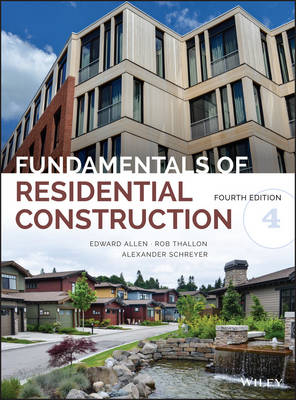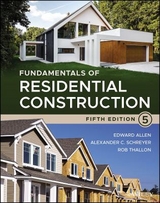
Fundamentals of Residential Construction 4e
John Wiley & Sons Inc (Verlag)
978-1-118-97799-6 (ISBN)
- Titel erscheint in neuer Auflage
- Artikel merken
The leading guide to professional home construction, updated and expanded Fundamentals of Residential Construction is the definitive guide to single family and multifamily home building that details every step of the construction process. From siting and foundations to finishing details, this book provides a complete walk-through of professional home construction. Over 1,200 drawings and photographs animate the textbook, while interactive supplementary online resources help facilitate an understanding of the material. This fourth edition accommodates the latest developments in materials and methods, including new coverage of sustainable building and energy efficiency, multifamily construction, prefabricated building components, and CAD/BIM planning tools in residential construction. Authoritative coverage of wood light-frame construction, building systems, industrialized fabrication, insulating concrete forms, light-gauge steel and masonry construction, multi-family buildings, and more provides a solid foundation in residential construction methods, tools, and processes.
Building a home requires a deeply integrated understanding of materials, structures, codes, and management procedures. Because the process involves such a broad array of considerations and challenges, construction professionals must regularly draw on a clear body of knowledge to keep a project running smoothly. This book helps you lay the groundwork of expertise required to successfully complete a residential project. Learn the advantages and disadvantages of common materials and systems Understand site preparation, foundations, and framing Delve into the details of roofing, finishing, and energy efficiency Understand heating/cooling, plumbing, and electrical options Examine the latest codes, costs, and management best practices Designing and constructing a home presents a unique project dynamic; people's homes are their sanctuaries, where they make the memories of a lifetime. They must be designed to be lived in, not simply "used." Lifetime costs play a major role in decision-making, materials must be carefully chosen and sourced, and spaces must be structured to be efficient yet enjoyable.
Fundamentals of Residential Construction shows you how to bring it all together to turn a project into a family's cherished home.
EDWARD ALLEN, FAIA, has a teaching career spanning more than thirty years, including as a faculty member at Yale University and the Massachusetts Institute of Technology, and is the best-selling author of The Architects Studio Companion; Architectural Detailing; Form and Forces; and Fundamentals of Building Construction, all published by Wiley. ROB THALLON, Associate Professor at the University of Oregon School of Architecture and Allied Arts, is the best-selling author and coauthor of Graphic Guide to Frame Construction; Graphic Guide to Site Construction; and Graphic Guide to Interior Details. ALEXANDER C. SCHREYER is Senior Lecturer and Program Director at the University of Massachusetts, Amherst, where he heads the Building and Construction Technology program and is a faculty member in Architecture. He is a wood engineering researcher and the author of Architectural Design with SketchUp, Second Edition, published by Wiley. www.wiley.com/go/resconstruction4e
Preface xi Acknowledgments xiii Part One Context for Building 1 Chapter 1 The Context for Residential Construction 3 1.1 History 4 1.2 A Culture of Building 6 1.3 Construction Systems 9 1.4 Types of Residential Development 11 1.5 Zoning Ordinances, Building Codes, and Other Legal Constraints 17 1.6 Building Costs and Financing 19 1.7 Building a House: The Typical Process 22 1.8 MasterFormat 26 Chapter 2 Sustainability Aspects of Construction 31 2.1 Why Sustainability Matters for Buildings 32 2.2 Environmental Responsibility: Building Green 35 2.3 Comprehensive Certification Systems 45 Chapter 3 The Construction Community: Builders, Contractors, and Developers 51 3.1 History 52 3.2 Builders and Contractors 54 3.3 Obtaining Work 58 3.4 The Residential Developer 60 3.5 Training the Construction Community 67 3.6 Green Builders, Contractors, Remodelers, and Developers 68 3.7 Tools of the Trade 70 3.8 Safety 72 Chapter 4 The Design Community 77 4.1 History 78 4.2 Residential Designers 79 4.3 Consultants 81 4.4 The Design Process 84 4.5 Design Sources 89 4.6 Communication between Designer and Builder 91 4.7 Green Designers 94 Part Two Materials 97 Chapter 5 Wood and Wood Products 99 5.1 Trees 100 5.2 Lumber 104 5.3 Wood Products 114 5.4 Chemical Treatment 127 5.5 Wood Fasteners 128 5.6 Wood-Manufactured Building Components 134 5.7 Types of Wood Construction 134 Chapter 6 Masonry 141 6.1 History 142 6.2 Mortar 145 6.3 Concrete Masonry 146 6.4 Brick Masonry 156 6.5 Stone Masonry 168 6.6 Other Types of Masonry Units 172 6.7 Special Problems of Masonry Construction 173 Chapter 7 Concrete 179 7.1 History 180 7.2 Cement and Concrete 181 7.3 Making and Placing Concrete 184 7.4 Formwork 188 7.5 Reinforcing 188 7.6 ACI 301 195 Part Three Wood Light Frame House Construction 199 Chapter 8 Rough Site Work 201 8.1 Design Considerations 202 8.2 Organizing the Site for Construction 203 8.3 Site Preparation 203 8.4 Excavation 205 8.5 Site Utilities 206 8.6 Surface Water Drainage 211 8.7 Grading 214 Chapter 9 Foundations 221 9.1 Foundation Loads 222 9.2 Foundation Settlement 222 9.3 Soils 223 9.4 Designing Foundations 224 9.5 Footings 226 9.6 Concrete Foundation Walls 229 9.7 Concrete Masonry Foundation Walls 232 9.8 Concrete Slab Foundations 233 9.9 Wood Foundations 240 9.10 Precast Concrete Foundations 240 9.11 Pier Foundations 240 9.12 Anchor Bolts and Hold-Downs 241 9.13 Drainage and Waterproofing 241 9.14 Foundation Insulation 244 9.15 Backfilling 246 9.16 Foundation Design and the Building Codes 247 Chapter 10 Floor and Wall Framing 251 10.1 History 252 10.2 The Platform Frame 253 10.3 Building the Frame 255 Chapter 11 Roof Framing 281 11.1 History 282 11.2 Roof Types and Parts 283 11.3 Building the Roof 285 11.4 Wood Framing and the Building Codes 301 11.5 The Uniqueness of Wood Light Frame Construction 303 Chapter 12 Finishing the Roof 309 12.1 Preparation for Roofing 310 12.2 Roof Slope 312 12.3 Steep Roofs 313 12.4 Low-Slope Roofs 326 12.5 Roof Edge Details 331 12.6 Roof Drainage 334 12.7 Roofing and the Building Codes 336 Chapter 13 Windows and Exterior Doors 341 13.1 Windows 342 13.2 Exterior Doors 354 Chapter 14 Finishing the Exterior Walls 363 14.1 The Weather Barrier Membrane 365 14.2 Exterior Trim 366 14.3 Siding 366 14.4 Exterior Paints and Coatings 375 14.5 Ladders and Scaffolds 382 Chapter 15 Plumbing 389 15.1 Plumbing Basics 390 15.2 Planning for Pipes 394 15.3 Rough-in Plumbing 395 15.4 Finish Plumbing 398 15.5 Plumbing Codes 398 15.6 Other Piping Systems 399 Chapter 16 Heating and Cooling 407 16.1 Choosing a System 408 16.2 Forced-Air Systems 410 16.3 Radiant Panel Systems 416 16.4 Other Hydronic Heating Systems 420 16.5 Ductless, Mini-Split Heat Pumps 421 16.6 Local Source Heaters 421 16.7 Finishing a Heating/Cooling System 425 16.8 Heating and Cooling Systems and the Building Codes 426 Chapter 17 Fireplaces and Stoves 431 17.1 Selecting a Fireplace 433 17.2 Planning for Fireplace Construction 434 17.3 The Masonry Fireplace 434 17.4 Masonry Heaters 444 17.5 Factory-Built Fireplaces 444 17.6 Freestanding Stoves 448 17.7 Fireplaces and the Building Codes 449 Chapter 18 Electrical Wiring 455 18.1 Wiring Basics 456 18.2 Electrical System Design 461 18.3 Rough-in Electrical Installation 464 18.4 Finish Electrical Work 466 18.5 Electrical Wiring and the Building Codes 467 18.6 Low-Voltage Wiring 467 Chapter 19 Thermal Insulation 471 19.1 The Thermal Envelope and Its Components 473 19.2 Thermal Insulation Materials 478 19.3 How Much Insulation? 482 19.4 Installation of Insulation 483 19.5 Control of Water Vapor 485 19.6 Ventilation of Cavities 487 19.7 Control of Air Infiltration 491 Chapter 20 Interior Surfaces 497 20.1 Wall and Ceiling Finish 498 20.2 Finish Flooring 505 Chapter 21 Finishing the Interior 517 21.1 Interior Doors 518 21.2 Cabinets 521 21.3 Finish Carpentry and Trim 528 21.4 Paints and Coatings 535 Chapter 22 Finish Sitework 541 22.1 Paving Systems 542 22.2 Level Changes 545 22.3 Porches and Decks 549 22.4 Finish Grading 550 22.5 Fencing 551 22.6 Outdoor Lighting 553 22.7 Irrigation 554 22.8 Planting 555 Part Four Alternative Construction Systems 559 Chapter 23 Panelized and Prefabricated Construction 561 23.1 The Concept of Prefabricated and Panelized Construction 563 23.2 Types of Panels 563 23.3 Framed Panel Systems 565 23.4 Structural Insulated Panels 568 23.5 Prefabricated (Factory-Built) House Construction 580 Chapter 24 Timber Frame Construction 587 24.1 The Uniqueness of the Timber Frame 589 24.2 Materials and Structure of the Timber Frame 592 24.3 Building a Timber Frame House 594 24.4 Timber Framing and the Building Codes 597 Chapter 25 Loadbearing Masonry and Concrete Construction 603 25.1 Loadbearing Masonry 604 25.2 Insulating Concrete Forms 610 Chapter 26 Light-Gauge Steel Construction 621 26.1 Light-Gauge Steel Frame Construction 622 Chapter 27 Low-Tech, Low-Energy Construction 637 27.1 Earthen Construction 638 27.2 Stacked Log Construction 646 27.3 Straw Bale Construction 651 Part Five Multifamily Building Construction 665 Chapter 28 Multifamily Construction Systems 667 28.1 History 668 28.2 Special Issues 671 28.3 Foundations 671 28.4 Framing 680 28.5 Acoustical Separation 687 28.6 Fire Protection 690 28.7 Systems 692 28.8 Accessibility 694 28.9 Site Management 695 Glossary 703 Index 727
| Erscheinungsdatum | 25.03.2017 |
|---|---|
| Verlagsort | New York |
| Sprache | englisch |
| Maße | 227 x 297 mm |
| Gewicht | 2086 g |
| Themenwelt | Technik ► Architektur |
| Technik ► Bauwesen | |
| ISBN-10 | 1-118-97799-8 / 1118977998 |
| ISBN-13 | 978-1-118-97799-6 / 9781118977996 |
| Zustand | Neuware |
| Haben Sie eine Frage zum Produkt? |
aus dem Bereich



